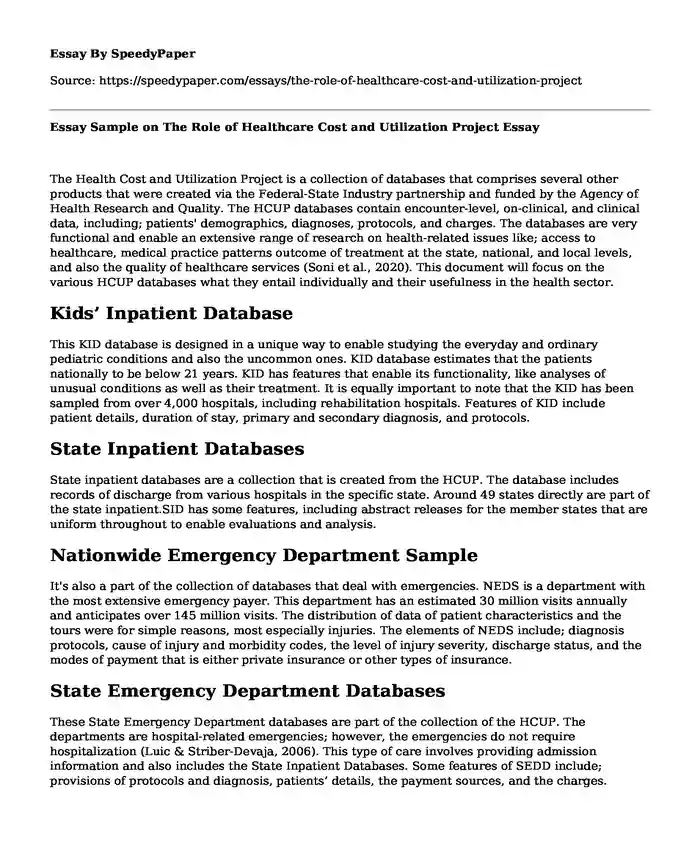
| Type of paper: | Essay |
| Categories: | Data analysis Healthcare Healthcare policy |
| Pages: | 3 |
| Wordcount: | 594 words |
The Health Cost and Utilization Project is a collection of databases that comprises several other products that were created via the Federal-State Industry partnership and funded by the Agency of Health Research and Quality. The HCUP databases contain encounter-level, on-clinical, and clinical data, including; patients' demographics, diagnoses, protocols, and charges. The databases are very functional and enable an extensive range of research on health-related issues like; access to healthcare, medical practice patterns outcome of treatment at the state, national, and local levels, and also the quality of healthcare services (Soni et al., 2020). This document will focus on the various HCUP databases what they entail individually and their usefulness in the health sector.
Kids’ Inpatient Database
This KID database is designed in a unique way to enable studying the everyday and ordinary pediatric conditions and also the uncommon ones. KID database estimates that the patients nationally to be below 21 years. KID has features that enable its functionality, like analyses of unusual conditions as well as their treatment. It is equally important to note that the KID has been sampled from over 4,000 hospitals, including rehabilitation hospitals. Features of KID include patient details, duration of stay, primary and secondary diagnosis, and protocols.
State Inpatient Databases
State inpatient databases are a collection that is created from the HCUP. The database includes records of discharge from various hospitals in the specific state. Around 49 states directly are part of the state inpatient.SID has some features, including abstract releases for the member states that are uniform throughout to enable evaluations and analysis.
Nationwide Emergency Department Sample
It's also a part of the collection of databases that deal with emergencies. NEDS is a department with the most extensive emergency payer. This department has an estimated 30 million visits annually and anticipates over 145 million visits. The distribution of data of patient characteristics and the tours were for simple reasons, most especially injuries. The elements of NEDS include; diagnosis protocols, cause of injury and morbidity codes, the level of injury severity, discharge status, and the modes of payment that is either private insurance or other types of insurance.
State Emergency Department Databases
These State Emergency Department databases are part of the collection of the HCUP. The departments are hospital-related emergencies; however, the emergencies do not require hospitalization (Luic & Striber-Devaja, 2006). This type of care involves providing admission information and also includes the State Inpatient Databases. Some features of SEDD include; provisions of protocols and diagnosis, patients’ details, the payment sources, and the charges.
State Ambulatory Surgery and Services Databases
It entails data for ambulatory surgery from hospital-acquired facilities and other outpatient services. Also, some other services like nonhospital-owned facilities. The information requires comparison from a variety of hospitals across the states
Nationwide Inpatient Service
This type of database, which is drawn from the family of databases, is established on all-payer hospital inpatient care in the U.S. This source contains data for over 7 million individuals and has an estimated 35 million hospitalizations. Its elements include discharge status, the severity of the infections, diagnostic procedures, and protocols.
In summary, health cost and utilization projects are large families of databases.it may include clinical and non-clinical data on patient's diagnoses and protocols. These various databases benefit the health sector differently; thus, all of them are equally important.
References
Liang, L., Moore, B., & Soni, A. (2020). National Inpatient Hospital Costs: The Most Expensive Conditions. Agency for Healthcare Research and Quality
Luic, L. & Striber-Devaja, D. (2006). The significance of information standards for the development of integrated health information systems. Institute of Oncology Sremska Kamenica, Serbia; 14(1-2): 64-6.
Cite this page
Essay Sample on The Role of Healthcare Cost and Utilization Project. (2023, Oct 16). Retrieved from https://speedypaper.com/essays/the-role-of-healthcare-cost-and-utilization-project
Request Removal
If you are the original author of this essay and no longer wish to have it published on the SpeedyPaper website, please click below to request its removal:
- Essay Example on Community Health Assessment
- Chemotherapy Essay Example
- Medical Essay Sample: Law and Ethics
- Spiro, Audrey. "New Light on Gu Kaizhi." Journal of Chinese Religions 16, no. 1 (1988): 1-17.
- Understanding Gifted Kids From the Inside Out. Paper Example
- Prescription Drug Abuse: 49 US States Combat with PDMPs - Essay Sample
- Ninhydrin: A Breakthrough Reagent Discovered in 1910 - Essay Sample
Popular categories




